Morfar: Spectacular Argentine Empanadas Take Over Split
July 19, 2022 - Morfar opened almost a month ago in Split, and it has caused a sensation not only among Argentinians and the Latin community in the city but among Croats and tourists alike. Total Croatia News caught up with Santiago Nieto, the owner of the Argentinian empanadería which is causing a stir in the Dalmatian city.
In my 27 years of life, I've never heard so much anticipation over a food joint opening before. Weeks before it happened, all I'd heard was "hey, did you know an Argentine empanada place is opening soon in Split?" After its long-awaited opening on June 21, all the people I knew in Split were telling me, ''have you tried Morfar's empanadas yet? They are spectacular!”. As a Peruvian, I understand what it is to feel proud of your gastronomy. And as a foreigner living in Croatia, I have learned to appreciate the efforts of people like me looking to make a place for themselves, and even more so if they can bring something from their country along the way. I not only wanted to try these famous Argentinian empanadas but also to know the history behind this initiative.
Just a few meters from the theater in Split, I find myself in Morfar. My first impression when I got to know the place for the first time was simple. ''This is the unofficial embassy of Argentina in Croatia'', I thought. The popular Argentine tango is heard on the speakers, a screen that can be seen from the street shows landscapes of Argentine Patagonia, and most importantly, anyone who passes by can see the warm empanadas on the counter. Inside, a variety of Argentine products are displayed on a shelf: fernet, dulce de leche, alfajores, yerba to prepare the popular mate, and Argentine wine. In a refrigerator, there are cold Quilmes beers and the popular chocotorta. Argentine flags and photos signed by legendary football players from the city of Rosario hang on the walls. "This is the unofficial embassy of Argentina in Croatia," I think again.
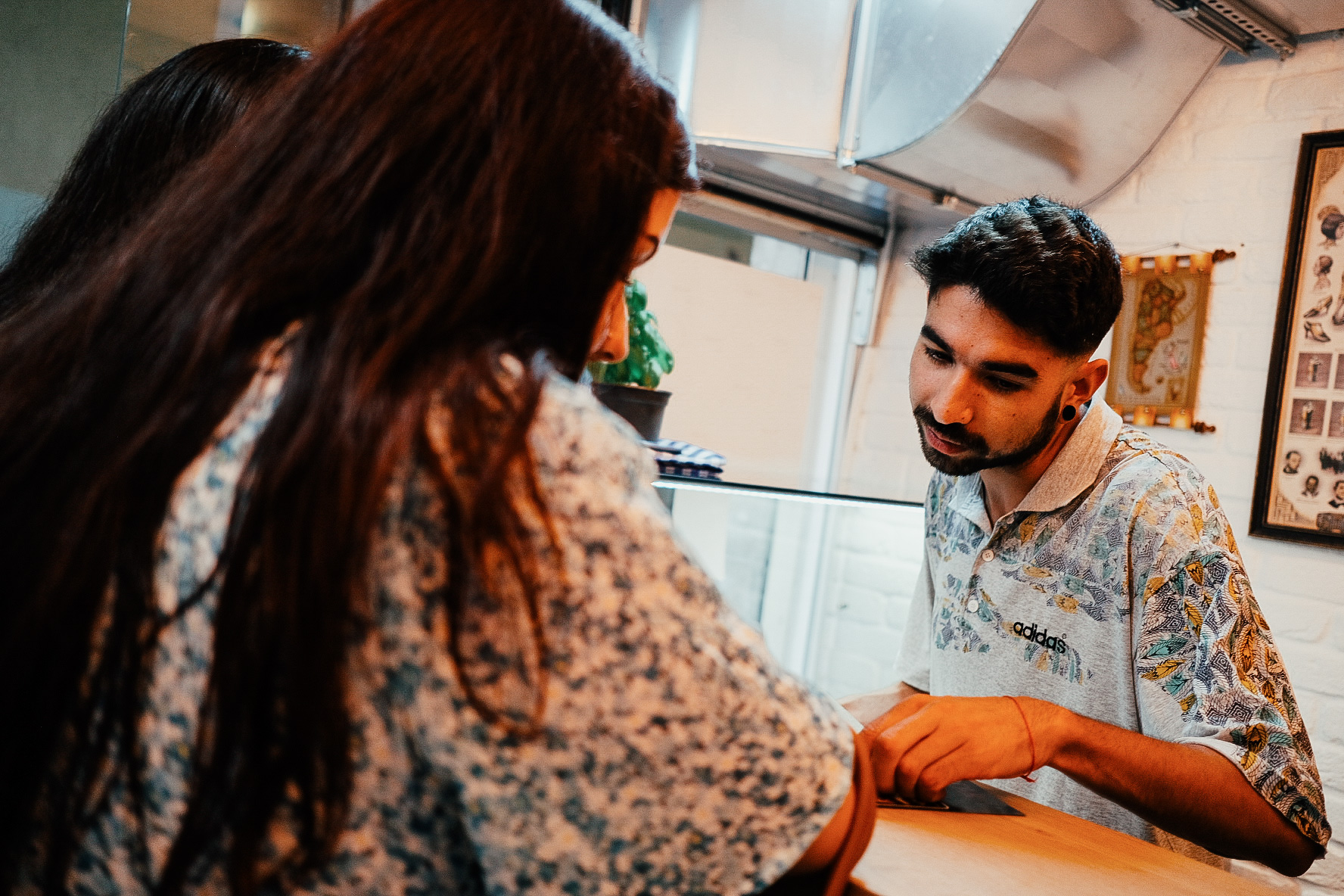
Santiago, owner of Morfar. (Photo: Jose Alfonso Cussianovich)
For those not familiar with Argentine empanadas, these are a type of baked or fried turnovers filled with a variety of savory ingredients and baked or fried. They are best eaten when they are still warm, and at any time of the day. Ideal for eating on the go, or even at home. At the counter is the charismatic Santiago Nieto, founder of Morfar. He not only makes sure that he treats all of his clients with love but also takes care of the marketing and promotion of his business. On this particular occasion, he also gave up some of his time (between multiple sold empanadas) to chat with Total Croatia News about the recently opened Morfar.
So you guys finally opened up Morfar!
We did, yes. We had planned to open on Monday the 20th, the day of the Argentine flag, but we had some bureaucratic problems, we ran out of electricity, so we had to solve it quickly and that is how we moved it to the next day, Tuesday the 21st. We had already organized an inauguration in style with music, percussion, and cymbals, as is usually celebrated in Argentina, but in the end, something more improvised and intimate with close friends came out, and it was still very good for us.
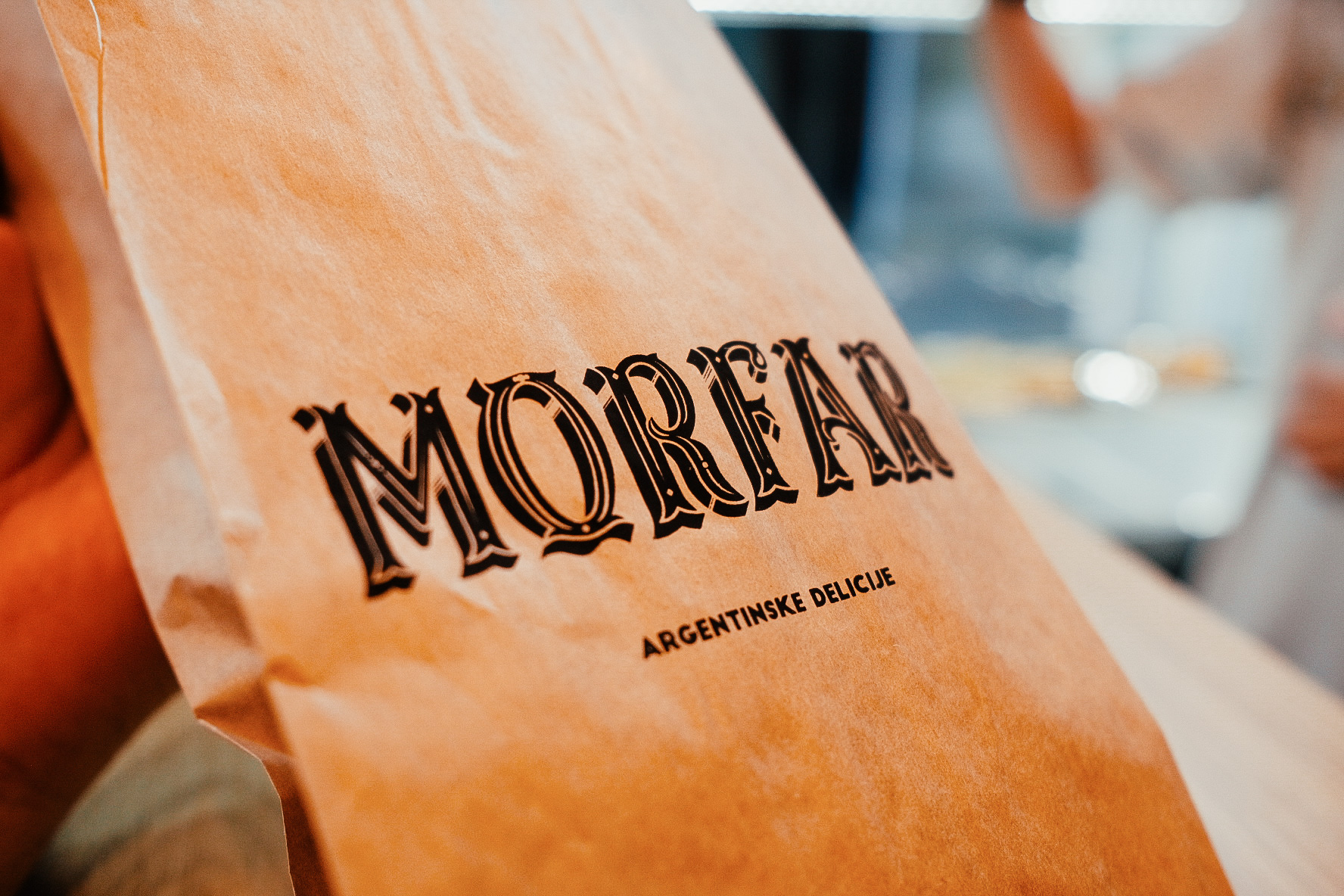
Photo: Jose Alfonso Cussianovich
Do you have Croatian ancestry? Tell us more about your connection to Croatia.
Yes, I do. I have family that lives here, but the one who migrated to Argentina was my great-grandfather at the beginning of the last century, in 1908 if I remember correctly. Hence my grandfather always told me about Croatia. My father's last name is Nieto, but my mother's name is Karaman, like the cinema in Split. They always told me about Croatia, but to me, as a child, it always seemed like something very far away and distant. It was not until I finished college and wanted to explore the world that I began to think about which place could open more doors for me, and later I came to Croatia through the scholarship offered by the Central State Office for Croats Abroad to study the Croatian language in Zagreb, which helped me to obtain my citizenship as well. This is how I arrived in 2018, 4 years ago, I studied the language in Zagreb, quickly obtained my citizenship, and after that, I came to Split where my family is from. I have two aunts here, my mother's second cousins, and cousins everywhere, and the truth is that they sort of adopted me and made me feel very comfortable, and that's how I stayed.
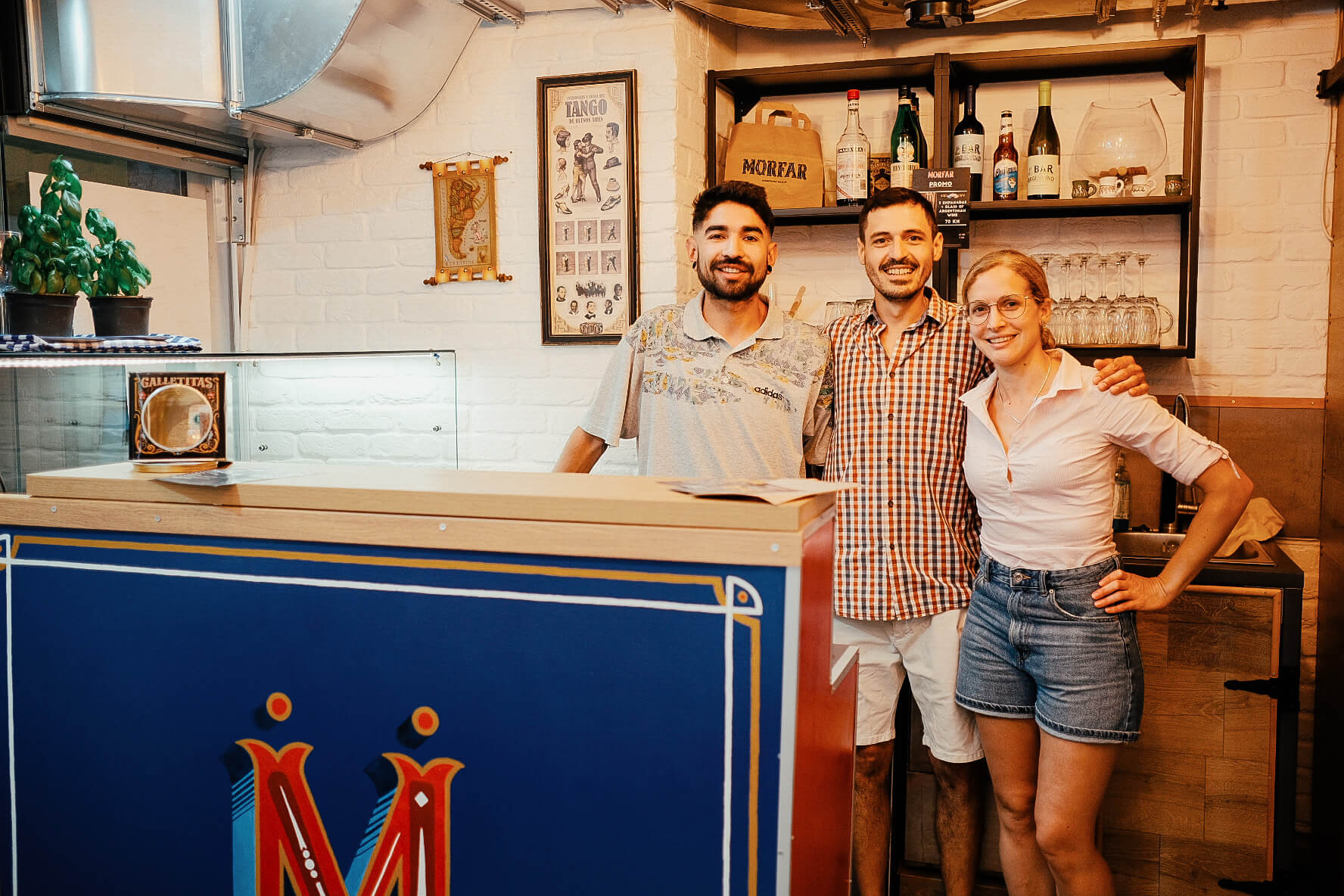
Santiago Nieto, David Folis, and Valeria Garcés, the masterminds behind Morfar.. (Photo: Jose Alfonso Cussianovich)
So you haven't been back to Argentina since then.
I returned to Argentina to get my degree. I came with my degree finished, but not with my thesis finished. Once here, I felt that I was getting very comfortable and I said to myself: ''you did five years of your degree, finish your thesis, and graduate''. This is how I put my life in Croatia on pause and returned to Argentina. Unexpectedly, COVID-19 appeared and what was initially five months in my country ended up being a year and a half. I finally came back in March of last year. A year and four months ago.
And how was your return to Croatia? How was the idea of Morfar born?
In 2021 I started to work in Marketing for Fig Restaurants, and on the other hand also in a restaurant called Republic Square, which has already closed in Split. So I was with Fig that season and the truth is that it was something that also motivated me a lot and I saw how a place was run, since I never worked in gastronomy. And being next to Geoff from Fig Restaurants he was like my mentor and he also motivated me to do this.
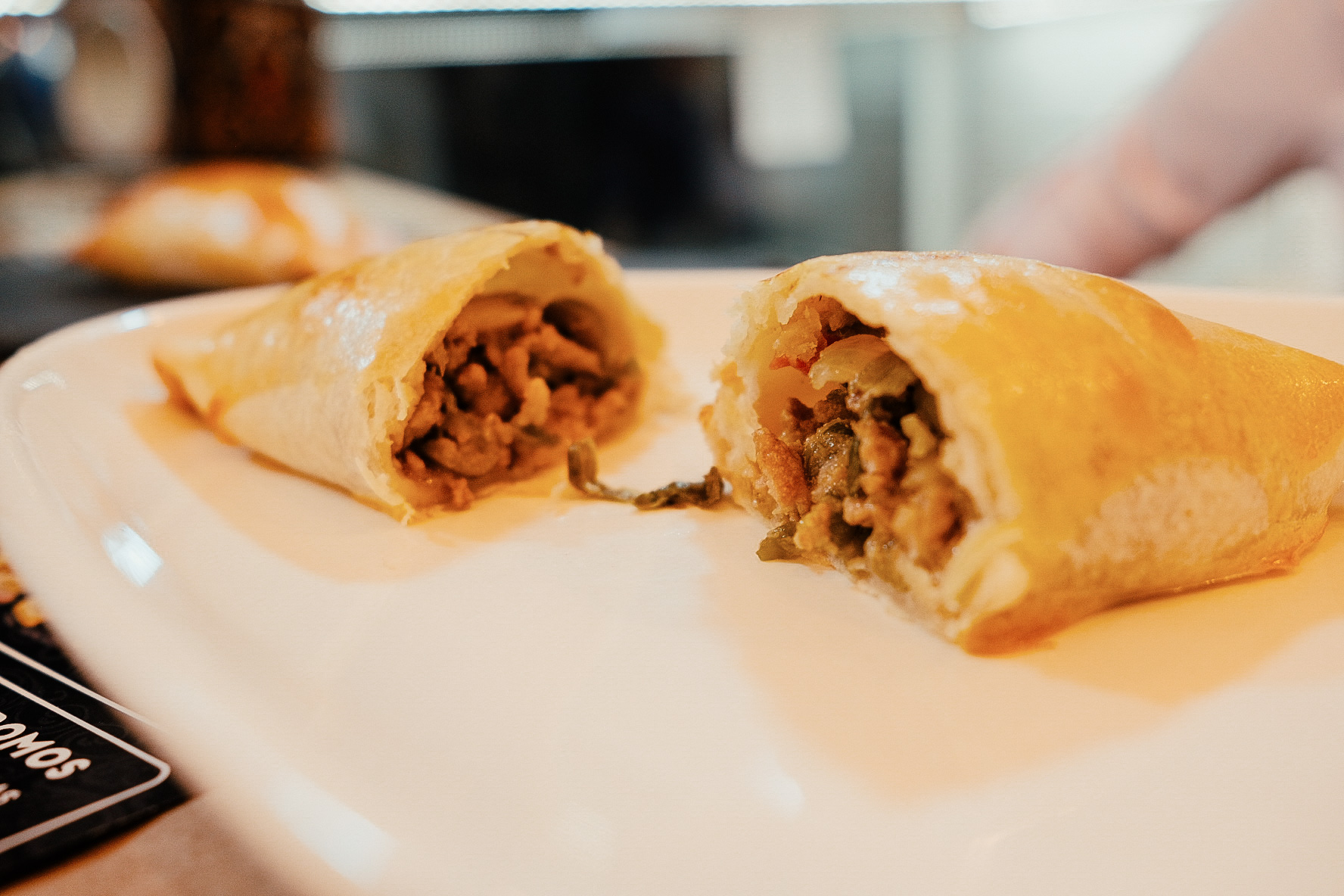
The empanada criolla. (Photo: Jose Alfonso Cussianovich)
When the season ended last year the other co-founders David and Valeria wanted to take the next step with empanadas since they were already selling them on Instagram back then. During that time we were already thinking about marketing, making advances in social networks, and planning a little, and shortly after they told me, ''don't you want to open a store?''. ''No way'', I thought. ''Open a store here in Split? I need to think about it a lot.''
But then I consulted with my family and with the people who know and those who wanted to help me, and they told me to go ahead, that if ''it doesn't exist, you are going to make it happen''. So from then on, in November of last year, we began to put together the entire business plan, we began to build the concept, to build the brand, how it was going to be, we began to look for spaces, delve into the bureaucratic and administrative processes which are a real nightmare and already in March of this year we found the place.

Photo: Jose Alfonso Cussianovich
Once you got the space, how did the project grow from then on?
I remember we told ourselves, before we found the space, that if we didn't find one in two weeks, we would start sending our CV's everywhere looking for work because we had to start this business this year no matter what. And well, we found it in March. And for two months we were working on the administrative procedures at the same time as the redesign of the place, with our own hands. Valeria is a calligrapher, David is a jeweler and I am in Marketing, and the three of us were building a store. It was crazy. And it was only on June 21 that we were finally able to open after all the bureaucracy.
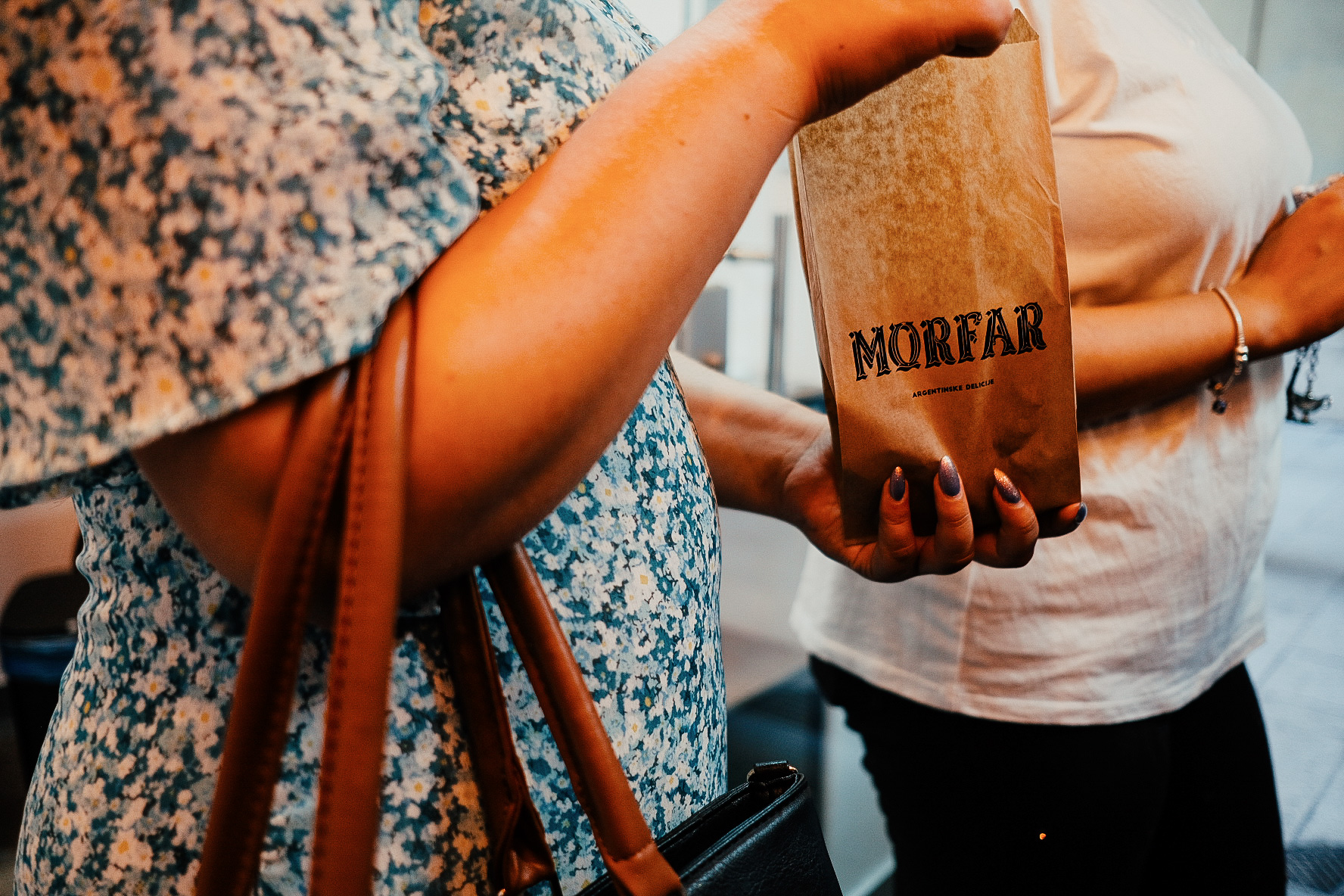
Photo: Jose Alfonso Cussianovich
Have you felt some kind of support from the Latin community in Split?
Many of us who studied the Croatian language together came to the country with the same goal, and that is why over time we got together a lot even after classes. I think I felt the most support when we opened Morfar, as we initially wanted to keep it low profile so as not to jinx it. But as soon as we opened, people began to arrive, many of them familiar faces, and they were very happy about what was happening and shared it on their social networks. In addition to buying our empanadas, they also came to chat and wish us good luck. Some even come to escape their usual routines. We like to be that holding space for them. People from the community also often pass by asking us for information or if we know of an available apartment. In the end, the support is mutual.
Why empanadas?
''People asked for it!'', says Valeria Garcés, one of the architects of the delicious empanadas. ''We have a friend at Marvlvs Bar, and there people always asked us for empanadas. Once, for an event a 25 de Mayo event, where everyone always has to bring something, we brought more empanadas. And that's when people told us that we had to do something more.'', she added.
''Once, when we were in Italy, some Italian girls who lived in France told us that they had loved something from Argentina that was made of dough and with meat inside, but they couldn't remember the name.'', recalls David Folis, one of the great empanada artists in the kitchen. ''And we ask them, 'empanadas?' 'Yes! Empanadas!', they answered. We realized that even in Europe they were quite popular!''.
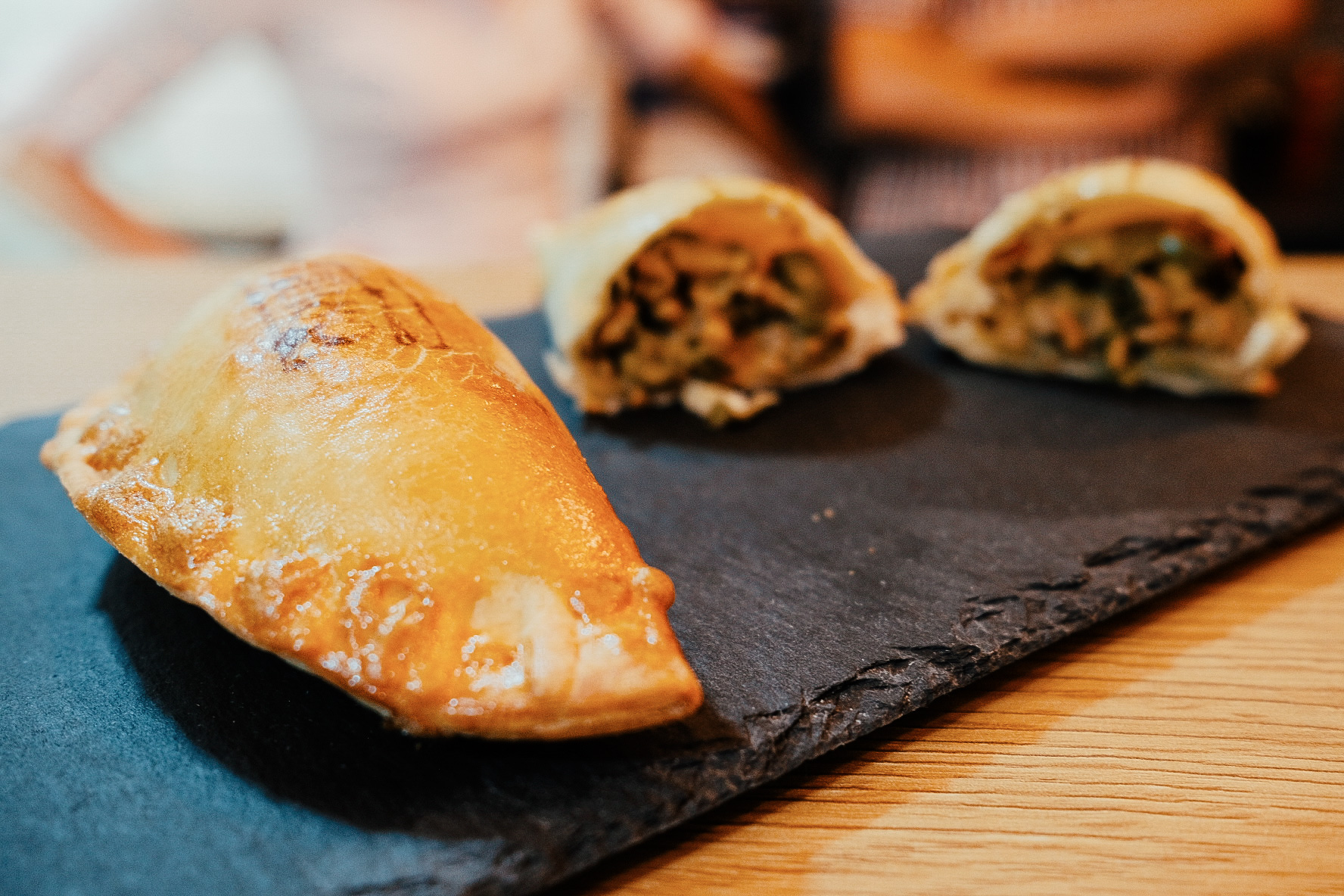
Photo: Jose Alfonso Cussianovich
Tell me more about the design of the store.
''We wanted it to feel like home, you can see it from the inside. But the most important thing is that we wanted to attract the curious.'', says Santiago. ''It's a good location, but it can also be a tricky one. That's why we did everything possible to attract the attention of people passing by, such as the logo or the screen. But mainly, when we were thinking about the design of the place, something that was mandatory was to have the empanadas to be displayed on a window. We wanted to place as many points of attention as possible, which are difficult to ignore'', he added.
''The thing is that Latinos know and have tried empanadas before. They are familiar with the word.'', argues David. ''But for those who have never tried one, they have to see it. We wanted them to see the empanadas and ask themselves, 'what are these'?''
''Food enters through the eyes'', Valeria explained.

Photo: Jose Alfonso Cussianovich
What's been the most surprising so far?
''We knew that Argentines and Latinos would buy empanadas. Considering that we opened at the end of June, our goal was to attract tourists who were in Split during the current season. What has surprised us the most has been the number of Croatians who have tried empanadas. We hadn't planned it!'', said Santiago, better known as 'Santi' among friends.
How come you started selling even more Argentinian products?
Our plan at first was to sell empanadas and alfajores. But as the days went by, more Argentines came and asked us ''Che, and do you have dulce de leche'', ''Che, and do you have yerba''?, ''Che, and do you have fernet?''. And that is how we have been adapting to the demands of the people. As a good Argentine, first we say yes and then we see how to make it work.
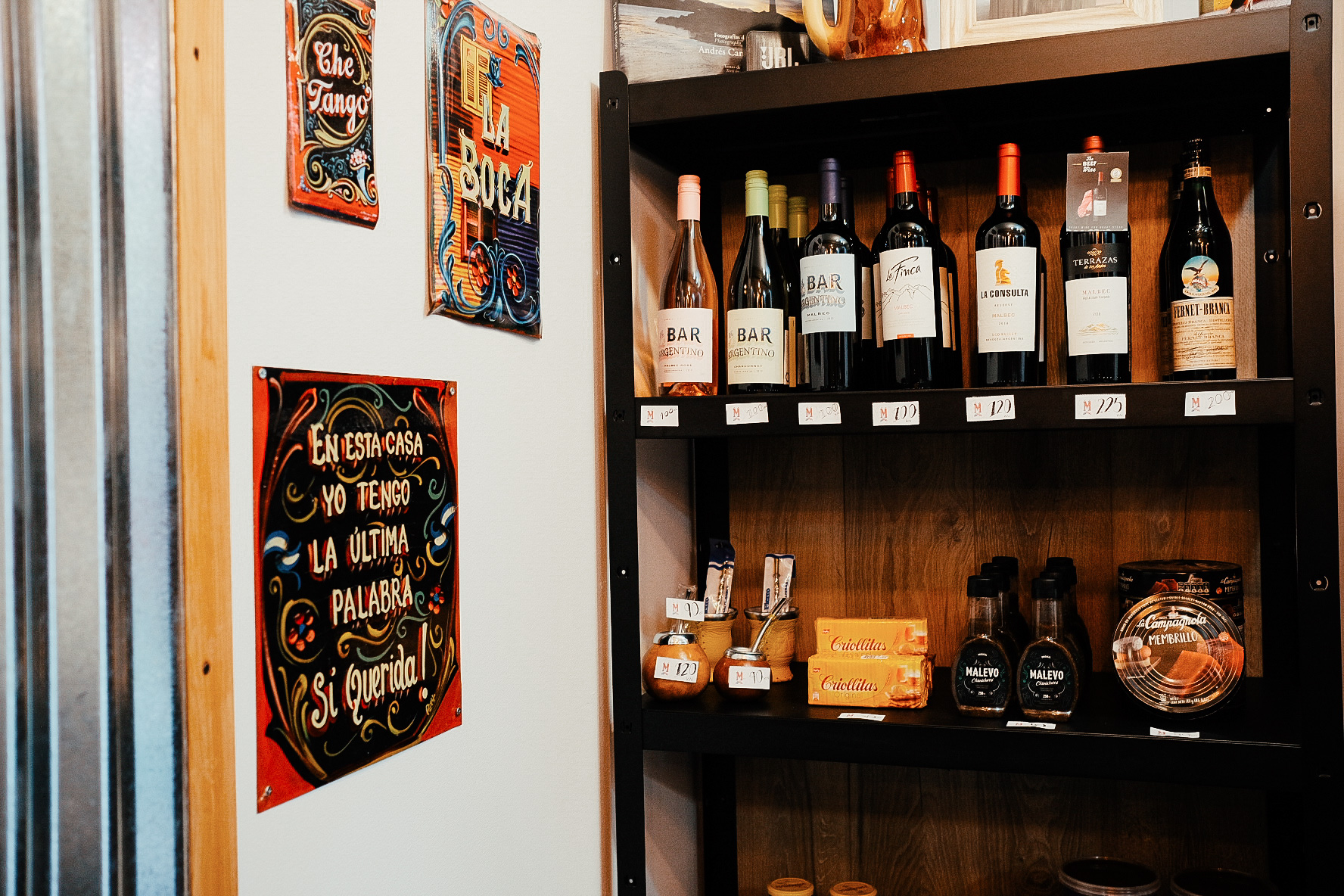
Photo: Jose Alfonso Cussianovich
Which empanadas are having the biggest impact so far?
''They have all had a great reception among the people. The empanada criolla is definitely the one with the most traditional flavor, but we see that the caprese and humita empanadas are also frequently bought.'', says Santi.
''And let's not forget the ajvar empanada!'', adds David. ''It has been well received not only by locals but by tourists alike''.
What goals do you have after the season?
''We have now extended our opening hours. We used to open from 5:00 p.m. to 11:00 p.m. We are now open every day, except Mondays, initially from 10:00 am to 1:00 pm, and then from 6:00 pm to 11:00 pm. After the season? There are times when I would like to close for a few days to rest'', jokes Santiago. ''We would really like to open all year round, even out of season. We know that there will not be so many tourists, but the locals and the Latin community will remain, with whom we have had a good reception these first few weeks. We would also like to open in other places, but we are going easy'', he adds.
"We also plan to add more flavors to our menu!," says David.
According to Valeria, ''In Argentina, one can find stores with up to 30 flavors of empanadas''.
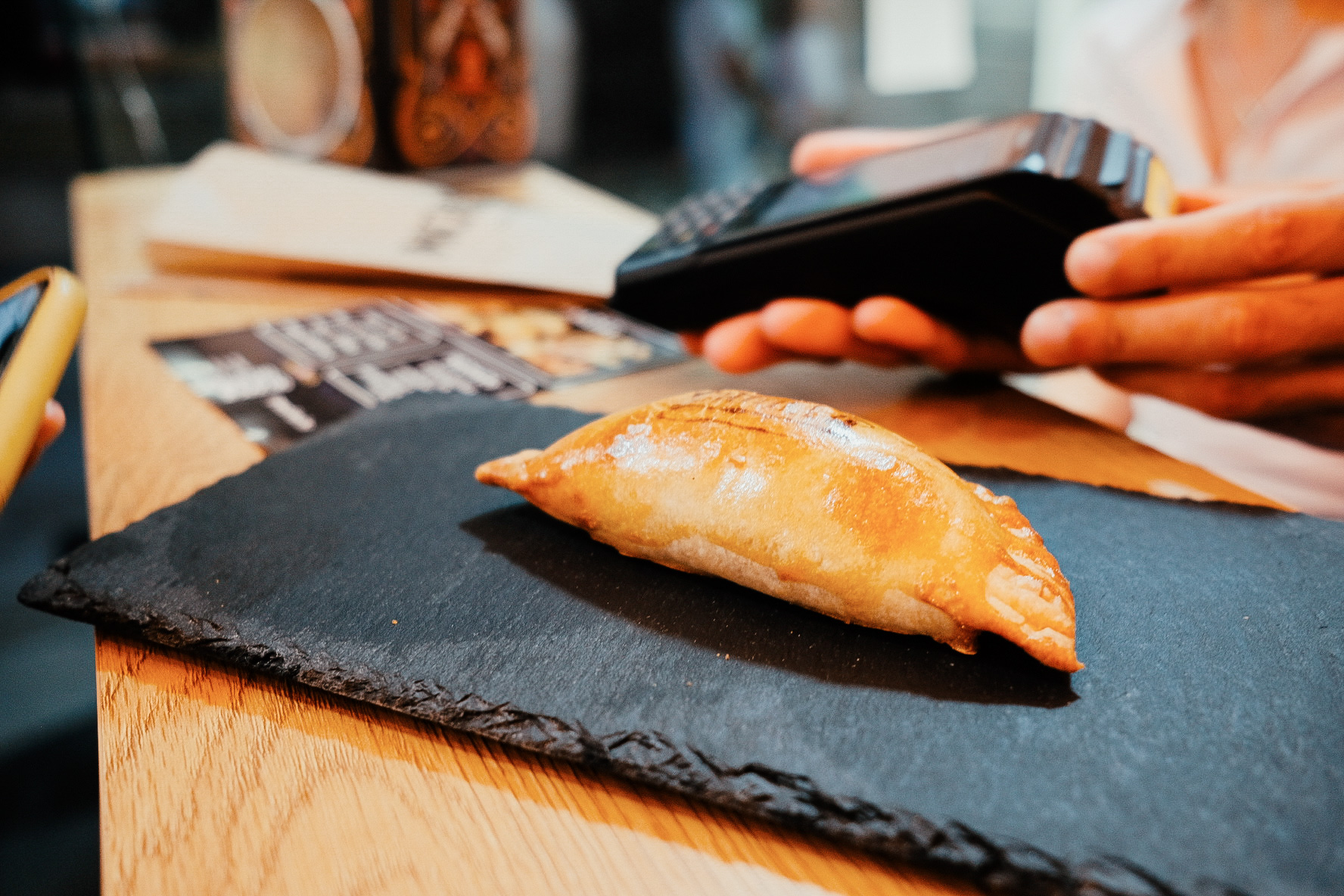
Photo: Jose Alfonso Cussianovich
Finally, what makes you very happy about this experience?
''It makes me happy when people say that the quality of our empanadas is comparable to those at home. I understand that there are not many in Europe to compare, but they have recognized the taste and quality of our empanadas and that is a great motivation.'', concluded Santi.
Morfar is located at 4 Porinova Street, just a few meters from the Split Theater, close to the Old Town. They are open from Tuesday to Sunday, first from 10:00 am to 1:00 pm, and then from 6:00 pm to 11:00 pm. You can follow them on Instagram, Facebook, and you can also share your experience on TripAdvisor.
Their empanadas flavors are the following:
- CRIOLLA: typical Argentinian with meat, olives, onions, peppers, green onions, and eggs.
- VEGAN CRIOLLA: Argentinian style but with lentils instead of meat.
- HAM & CHEESE
- CAPRESE: mozzarella, tomatoes, and basil.
- HUMITA: corn, mozzarella, and onions.
- AJVAR: inspired by the traditional sauce that goes with ćevapi, eggplant, peppers, and onions.
- SIR KAPULA: onions and mozzarella.
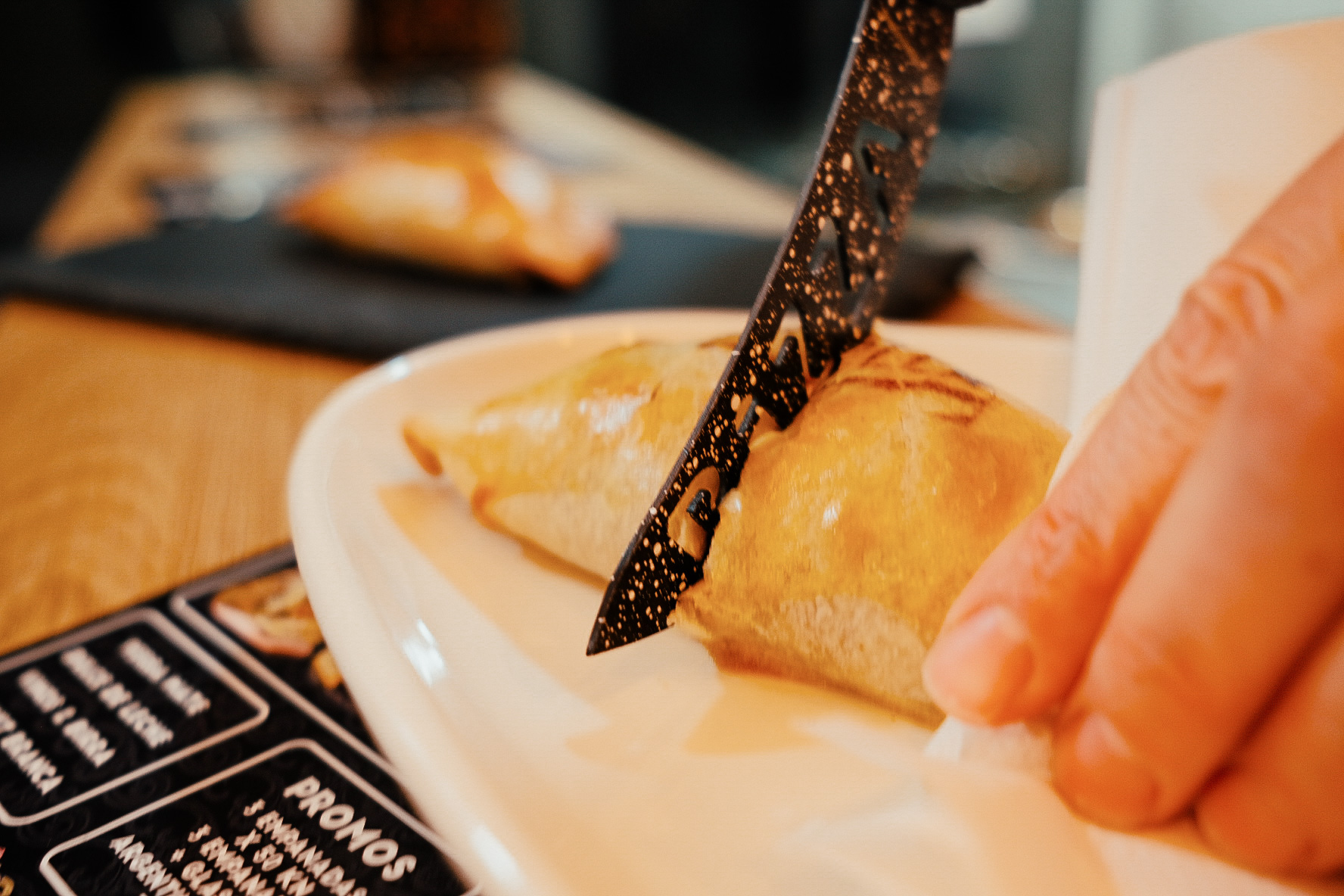
Photo: Jose Alfonso Cussianovich
The price of each empanada is 20 kuna. You can take three empanadas for 50 kuna! Also, ask about the promotion of an empanada with a glass of Argentinian wine. Additionally, on Saturdays, you can order a special Morfar pizza!
For more, check out our lifestyle section.
For more news about the Croatian diaspora, visit our dedicated section.
Argentines Can Now Trace the Ship Their Croatian Ancestors Arrived On
May 9, 2022 - The Center for Latin American Migratory Studies developed an online search engine that allows you to find out, in just three steps, on what date and on what ship your Croatian ancestors set foot on Argentine soil.
Only with the surname, name, and validating the Captcha code it is possible to access the date of arrival of each of the immigrants who arrived in Argentina between 1800 and 1960, reports infobae.com. You will also be able to know which ship your Croatian ancestors traveled on and which port on the Argentine coast they arrived at.
All of this is now possible thanks to the online search engine of the Center for Latin American Migratory Studies (Cemla), which also allows us to find out what profession or occupation your Croatian ancestors had and from where in Europe they left. This possibility of knowing the history of each family that arrived in the country is the result of one of the most important tasks carried out by the organization, due to its meaning and scope.
Cemla was founded by Father Luigi Favero on December 28, 1985, preceded by the First Conference on Immigration and Identity, held in August of that year, and by the publication of the initial number of Latin American Migratory Studies, the first academic journal dedicated to exclusively to migratory issues in the subcontinent.
It also has an important Documentation Center specialized in national and foreign migrations from Argentina that has the objective of preserving the records of entry into the country for each of its ports as the first specialized library dedicated exclusively to migrations from Argentina. Currently, it has more than four thousand volumes between books and serial publications.
At the end of the 19th century and during the first decades of the 20th century, the great wave of European immigration to Argentina took place. Those who arrived, for the most part, came from Italy and Spain, but Ukrainians, Poles, Russians, Croats, French, Germans, Swedes, and Irish, among others, also arrived.
According to data from the University of Tres de Febrero and the book "Migration Policies in Argentina" by Susana Novick, between 1880 and 1915 more than 1,500,000 Europeans arrived on Argentine soil.
How to search in three steps
1. Enter the link: www.cemla.com/buscador/ (DUE TO GREAT DEMAND, THE DATABASE MAY PROVIDE ERRORS)
2. Write the surname and first name of grandparents, great-grandparents, or relatives who arrived in Argentina between 1800 and 1960.
3. Validate the Captcha code

Image: infobae.com
Among its first tasks, Cemla began the preservation and microfilming of documentary sources of immigration in Argentina and, in particular, Italian immigration in Argentina, Uruguay, and Chile.
With the same desire to preserve history, it held special Congresses and Conferences that included the participation of specialists from various disciplines from both Argentina and Latin America.
For more news about the Croatian diaspora, visit our dedicated section.
Croatian Diaspora in South America: The Story of Nadia from Argentina
June 17, 2021 - Reuniting with your Croatian ancestry can go in many ways. Many of the Croatian diaspora in South America tirelessly seek to trace their roots, and several of them without success. The chances of accidentally meeting your distant relatives are always low, but this is what surprisingly happened to Nadia from Argentina.
Every year, lists are written in media and blogs everywhere to rank Croatian destinations, facts, and people, but I don't know if it has occurred to anyone before that Croatia, in addition to its beaches, its islands, its nature, its Roman, Venetian, Austro-Hungarian, and Yugoslav heritage, its geniuses (both in science and sport) and more, Croatia could also be known for its surprises. It is true that being Croatian, of Croatian descent, or living in Croatia can surprise one on various occasions, and not always in a negative way.
Of course, there are known surprises that one can get when going to the police station to carry out a procedure, or when sitting at the table of a Croatian family at lunch, or after a rakija tasting. But some of its most interesting events happen when reconnecting with your Croatian ancestry. Not only through my own experience, but I know of many, many people over the years who have failed to find out more about their ancestors rather than the simple fact that they were Croats.
As the years go by, it becomes more difficult to connect the evidence that one finds to solve numerous questions such as the year their ancestor was born, where they were born, when did they leave Croatia, why did they leave Croatia, what did they do while living there, what did they do after arriving at their new country, and so on. This is very difficult to solve, especially for the large Croatian diaspora in South America, a distant continent in so many ways beyond what’s measurable. If there’s something I know, it is that one of the decisions that can facilitate this search is to return to the mother country. It is not a guarantee, but it can definitely bring you closer to the answer you are looking for.
But what if one is not looking for it? It does not mean that there is no type of interest, but precisely it ceases to be a priority when it becomes so difficult to know something about our origins. When you find something you were looking for, it always brings a pleasant sense of success and fulfillment. But when it is unexpected, the feeling of joy can be equal or even greater. This is what I thought when I first heard about Nadia's experience. But I feel like the story will feel more magical if it is shared through her own words. Meet Nadia Milevčić, a returnee from Argentina.
What country are you from and when were you born?
I am from Argentina, I was born in Buenos Aires in October 1994.
When did you know that you were of Croatian descent?
I can't give you an exact date because it's something I've known for as long as I can remember. Perhaps because of my last name, the fact of being of Croatian descent was always something very present. My dad's four grandparents were Croatians and he talks a lot about them and the things they taught him. My grandmother, daughter of Croats, used to speak to me in Croatian when my brother and I were young. She also told me about our family, about the city of Split in Dalmacija, and about the history of Croatia as a country. For all these things, the Croatian heritage was very important in my family.
When did you decide to travel to Croatia and what motivated you?
In 2018 I started thinking about studying abroad because I wanted to have the experience of living in a totally different environment from mine. First I thought that this trip would be related to something in my career. At that time I had two years left to finish my Bachelor of Arts degree and I looked for some scholarships in other countries, but nothing appeared.
I started thinking about studying in Croatia when I went to the Buenos Aires embassy to find out how to begin the process of Croatian nationality and the woman who worked there told me about the Croaticum program. It seemed to me that the idea united my desire to live in a totally new place and also my desire to finally know that country that I had been told so much about. In March of that year, I began to work on my project and began to study Croatian in Buenos Aires while waiting for the opening of the call for the scholarship program. That year I applied but did not win. It was very disappointing, but later I understood that it was not yet my time to leave Argentina. In 2018 I also finished the annual Croatian course and continued to search for papers that could help me to prove my Croatian ancestry more clearly.
In 2019, the last year of my degree, I applied for the scholarship again and won it. That same year, a distant cousin of mine contacted me from Croatia saying that we were family. At that time my idea was not only to get to know the country of my great-grandparents and live in it for a while but also to reestablish the bond with the rest of my family in Croatia, of whom I did not know any of them.
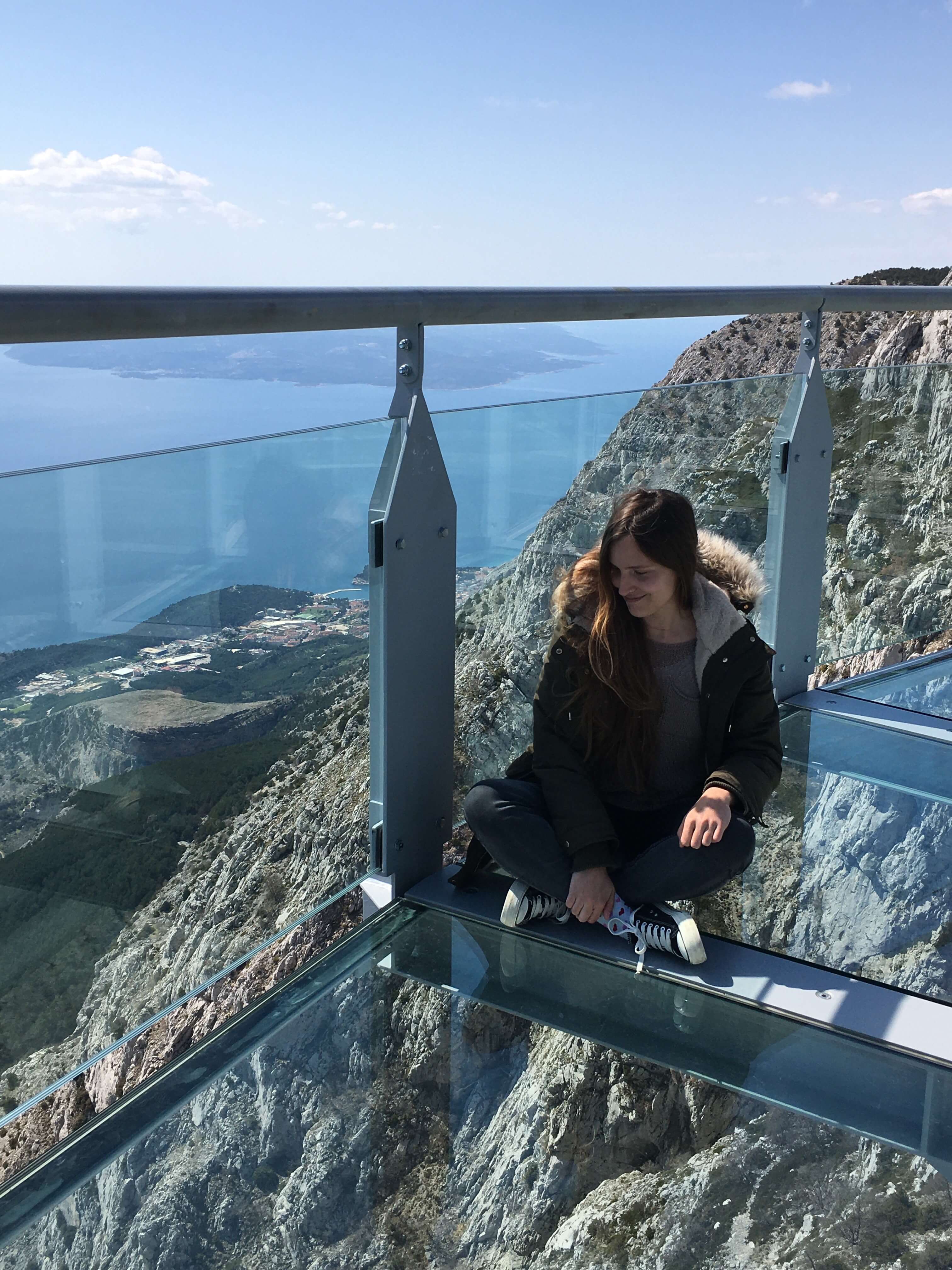
Nadia on the popular Biokovo Skywalk, the same day she met her distant Croatian relatives. (Personal album)
What was your impression when you first arrived?
My first impression of Croatia was that everything was very beautiful and that the people were very friendly. When I met my cousins they seemed to me to be very open and very loving people. The first month I was delighted with everything I saw, it seemed to me that everything was very organized and I felt very safe.
How did that impression evolve over time?
After living here for a year and having moved several times, I also began to see the negative side. All countries have something good and something bad, it is normal. There are things that I don't like and I think that's part of living in the reality of a country and getting out of that stage of infatuation in which I was at the beginning. Now I have a more realistic impression.
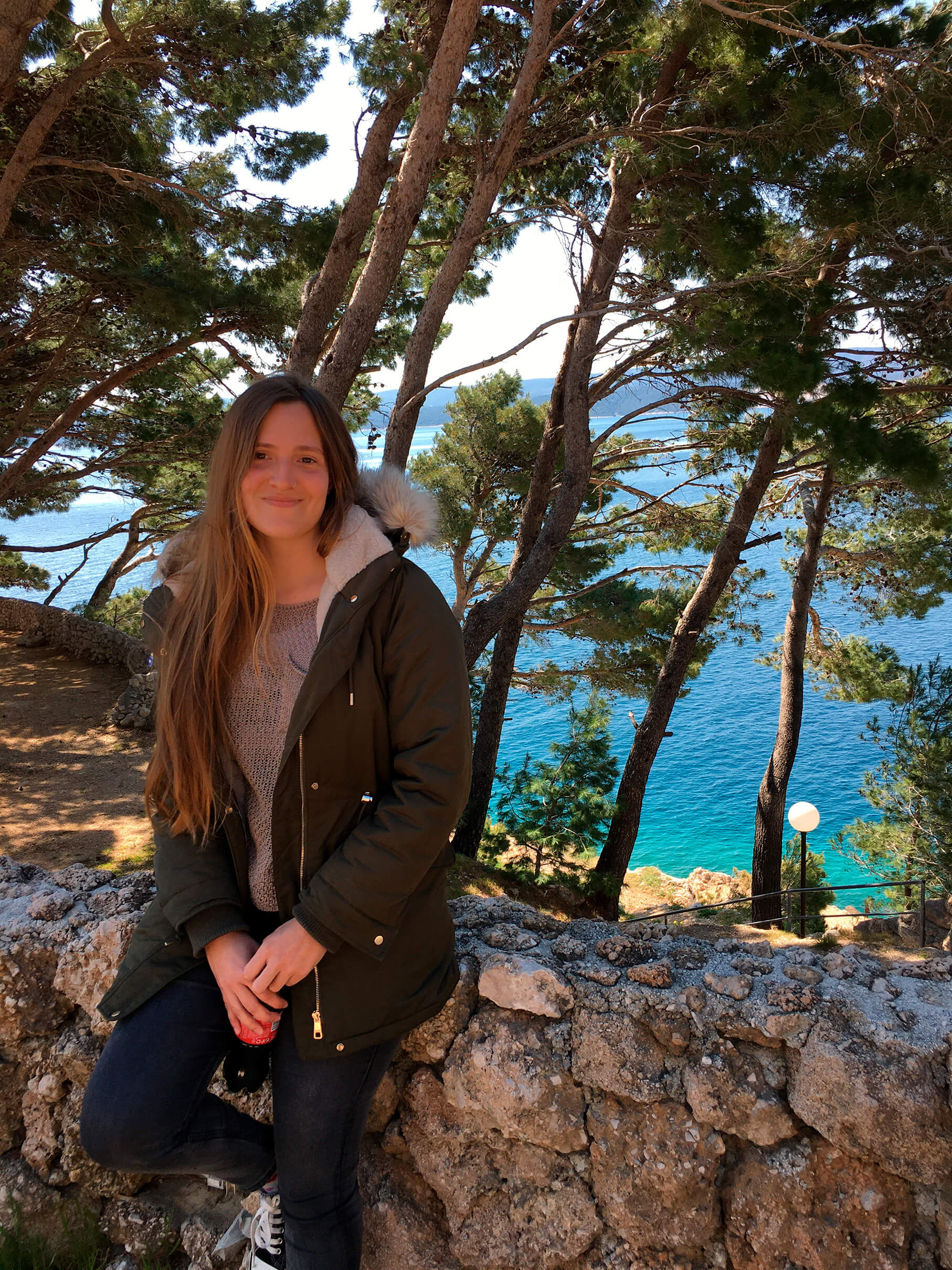
Nadia was born in Buenos Aires, Argentina, in 1994. All of her grandparents are Croatian. (Personal album)
What did you know about your relatives in Croatia?
It was always quite a complicated story because all of my dad's grandparents are Croatian and most of them had a very large family. I know a lot about my great-grandmother Ermenegilda Stanić because they were like twelve siblings and my grandmother went to Argentina because my great-great-grandfather arranged her marriage to a rancher so that she would have a good future in financial terms. When she arrived in Argentina she fell in love with my great-grandfather Duje Runje, a Croatian who worked as a laborer in that ranch. Obviously, it was something very strong for all of his family and my dad always talked to me about the two of them. He doesn't have much information about his paternal great-grandparents because my grandfather, Spiro Milevcic, died when my dad was four years old.
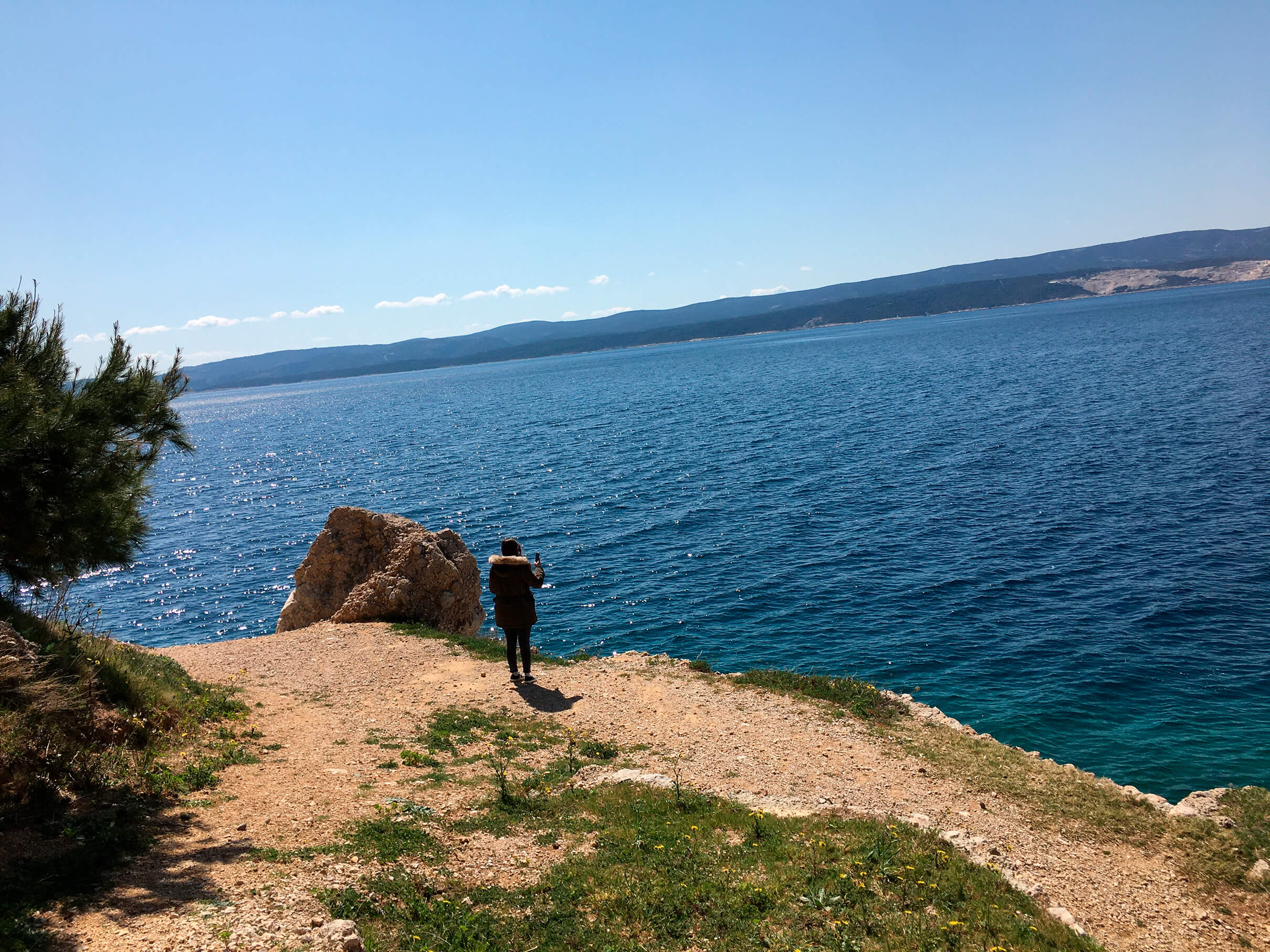
Nadia, who was living and working in Rijeka at the time, decided to travel to Dalmatia for vacation. She hadn't planned to find out about her family on the trip. (Personal album).
Did you have any expectations or plans to meet them?
Yes, my dad has a book that the Stanić family wrote about the descent of the twelve siblings. All the names appear there, including mine. The whole family has it and thanks to that my cousin contacted me from Croatia. It was just the same year that I won the scholarship. She told me that she lived in Rijeka and thanks to that I chose this city as the place where I was going to study for the Croatian language scholarship. This is how I met the descendants of one of the Stanić brothers, but I also knew that she had much more family in Croatia. Last year I didn't meet anyone else because most of them live in Dalmacija.
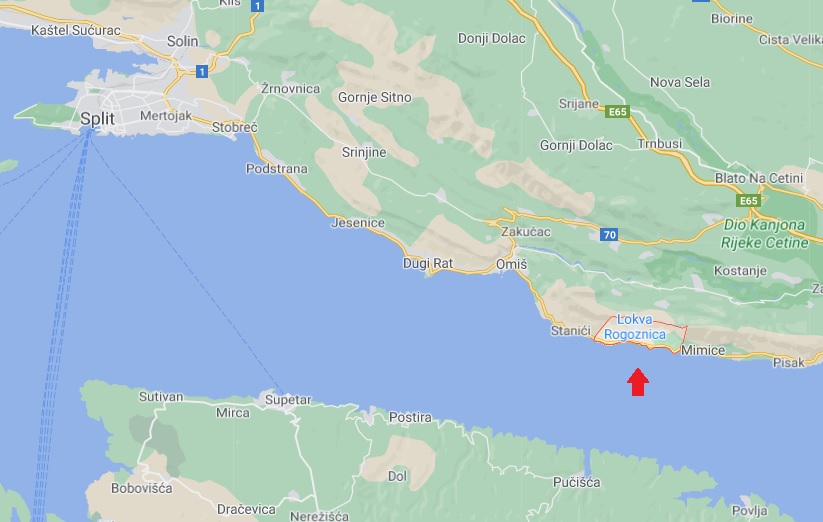
Lokva Rogoznica is a Dalmatian town, one hour away south of Split and 10 minutes away from Omiš. (Google Maps)
The day you met your distant relative, what were you doing and where?
Last month I went on vacation to Split and decided to go to Lokva Rogoznica, a town about an hour away because my great-grandmother was born there. My dad and my Croatian cousins had asked me to go meet him, but it was not my plan to look for anyone there, just take a couple of photos and see what the place was like.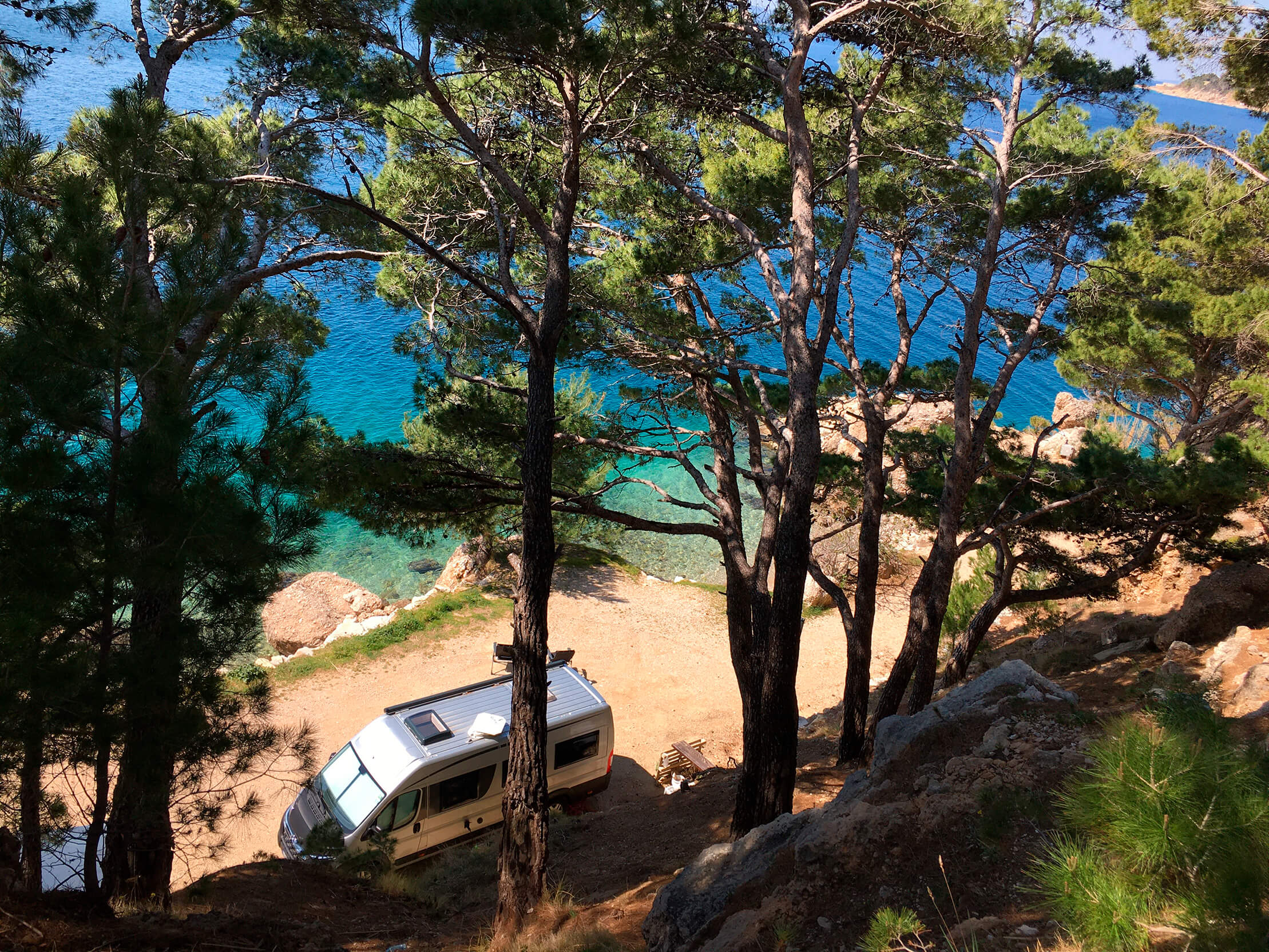
''La Sirena'' autokamp, in Lokva Rogoznica, the town where Nadia's family originated. (Personal album).
How was the encounter?
We stopped at a sign on the route to take a picture of me and we wanted to go down to the beach. I saw that there was a sign for an autokamp and that the beach was private. I remembered my cousins telling me that one of the Stanić was the owner of a campsite somewhere in Dalmacija, but I didn't know where. When we were about to go down to the beach, the owner of the campsite appeared and told me that the beach was private and that we couldn't enter. I don't know why it occurred to me that this could be my relative and I asked him if his last name was Stanić. He said yes and at that moment I told him that we were family because I was Ermenegilda's great-granddaughter. At that moment his face changed completely and he asked me if my great-grandmother had traveled to Argentina. When I said yes, he came closer to me and gave me a hug, and introduced himself as Milan Stanić.
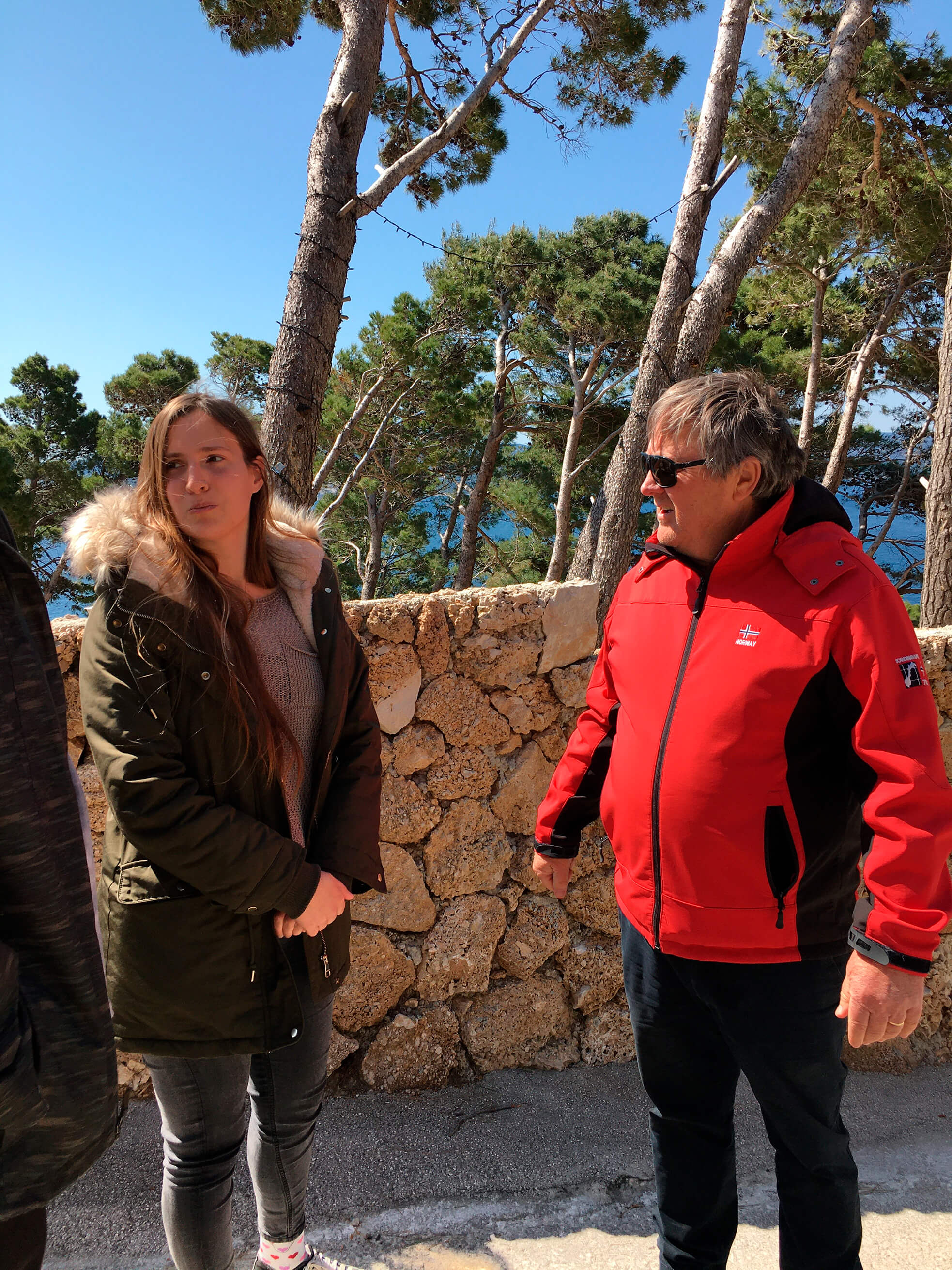
Nadia, soon after she met her distant relative, Milan Stanić. (Personal album)
How did you feel when the last names matched?
I felt very good and very strange at the same time. I was thinking of my dad because his desire was always to meet his Croatian family. I was the first person in my family to return to Croatia and from the first moment, I felt that it was my task to re-establish the bond with the other descendants. I also thought that I had come to take a photo and I ended up leaving with one more piece of my family. I like to think that it was something that had to happen and that it was time for us to meet.
What was his reaction when he found out?
He was very excited and very happy. From the first moment, he was very open with me and he introduced me to all of his family. That day we had lunch and dinner together. It was a very nice moment because all his daughters and his wife welcomed me very well and everyone was interested in talking to me.
Are you still in touch with him?
We don't talk every day, but I have his number and my cousin’s Facebook, so I can let them know the day I'm going to visit them again. They know that I am living in Rijeka and that I am working, but that at the end of the summer I am going to travel with my brother so that he can meet them too.

Milan, his daughter, and Nadia. (Personal album)
What is your goal in Croatia? Would you like to stay?
My idea of Croatia totally changed over time. When I arrived I planned to stay for only four months to study, but then I applied again for a second semester. I think that the decision to reapply for the scholarship was no longer motivated by the desire to know another culture, but was related to the fact that I felt good in Croatia and that I still did not want to go back to Argentina. Nowadays I am more established with the Croatian language and culture, but I cannot tell you that I want to stay permanently. I feel a strong connection to Croatia, but I also have my best friends and family in Argentina. Every day I miss my country and the people who live there and that is why I know that I will return to my country at some point. I sincerely feel that one half is here and another half is there in Argentina and for that reason, I would like to go and come back, spend some time in each country. I think it is a decision that is made every day. I can only tell you that today I choose to stay here.
The Croatian diaspora in South America is one of the largest in the world, and we at Total Croatia and Total Croatia News are committed to developing more on the subject in the coming months. If you belong to the Croatian diaspora in South America and want to share with us a story of reuniting with your distant relatives or your experience living in the land of your ancestors, you can send an email to This email address is being protected from spambots. You need JavaScript enabled to view it..
For more about the Croatian diaspora in South America, visit our dedicated page here.


